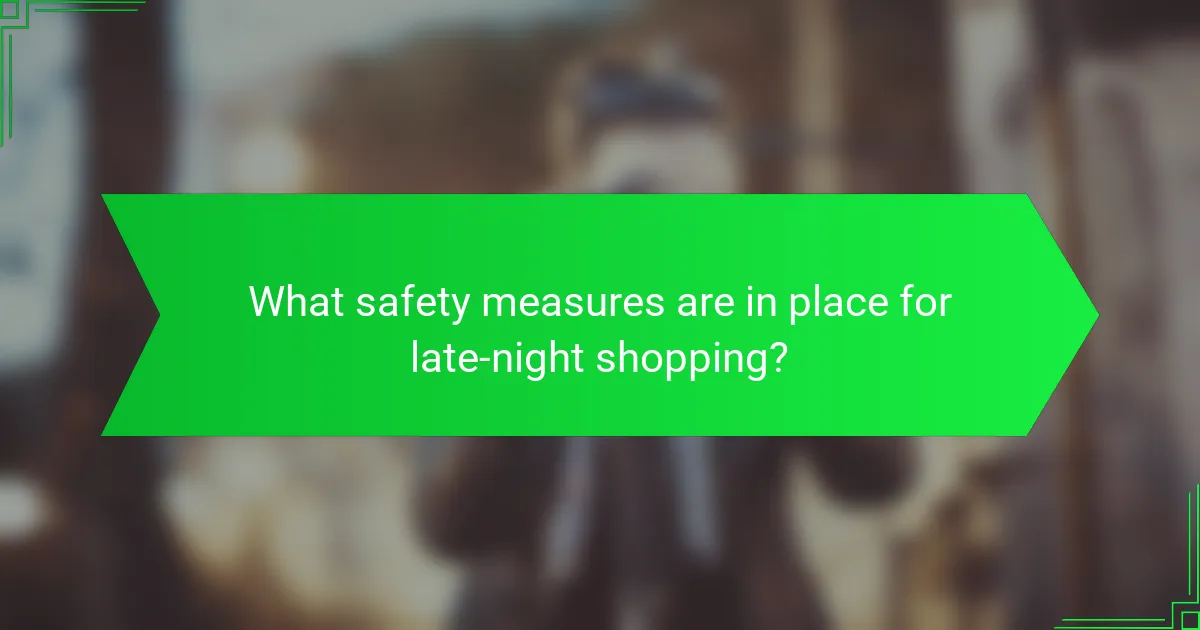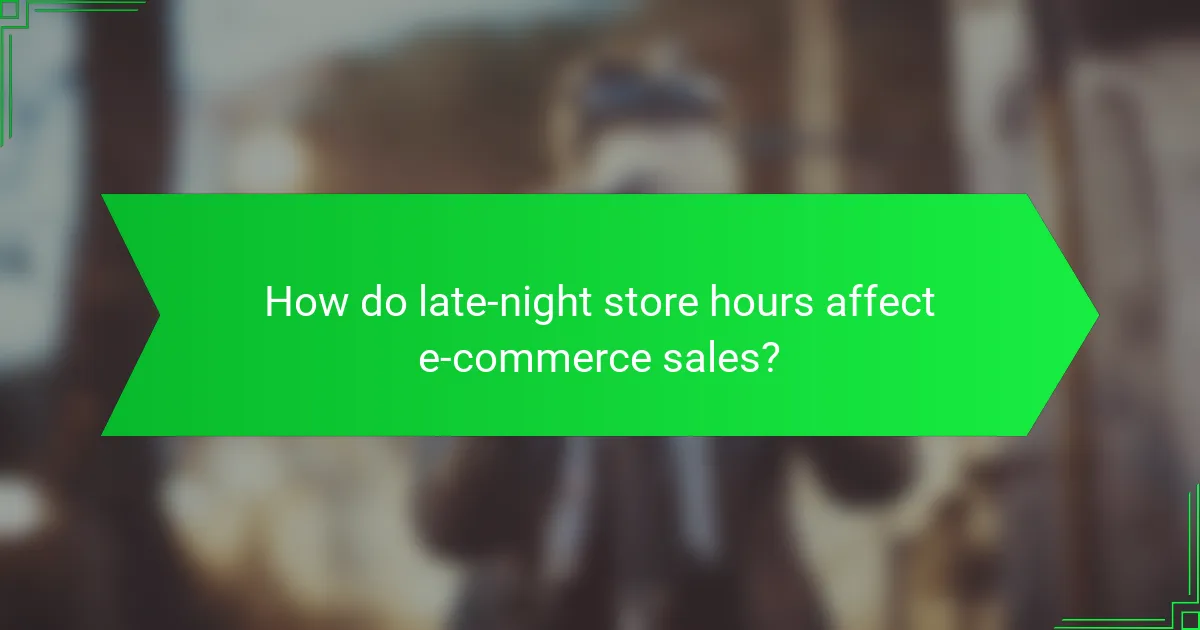Late-night store hours in urban areas generally range from 9 PM to 2 AM, accommodating the needs of consumers seeking convenience and accessibility. Urban shoppers prioritize safety and a variety of products, often gravitating towards convenience stores and select supermarkets that offer extended hours. To enhance the shopping experience, retailers implement various safety measures, ensuring both consumers and staff feel secure during late-night operations.

What are the late-night store hours in urban areas?
Late-night store hours in urban areas typically extend from around 9 PM to 2 AM, depending on the type of retailer and local regulations. Many convenience stores and some supermarkets cater to late-night shoppers, while larger retailers may close earlier.
Typical hours for major retailers
Major retailers often have varying late-night hours. For example, grocery stores may stay open until midnight or 1 AM, while convenience stores frequently operate 24 hours. Big-box retailers like Walmart usually close by 11 PM, though some locations may offer extended hours on weekends.
Variations by city
City regulations and consumer demand significantly influence late-night store hours. In larger metropolitan areas, such as New York City or Los Angeles, many stores remain open late to accommodate diverse shopping habits. In contrast, smaller cities may see earlier closing times, often by 10 PM.
Impact of local regulations
Local laws can dictate store operating hours, especially concerning alcohol sales and noise ordinances. Some cities impose restrictions on late-night operations to reduce disturbances, while others encourage extended hours to boost economic activity. Retailers must comply with these regulations to avoid fines or penalties.

How do urban consumers prefer to shop late at night?
Urban consumers typically prefer convenience and accessibility when shopping late at night. They often seek stores that offer extended hours and a variety of products, prioritizing safety and ease of payment.
Popular shopping categories
Late-night shoppers in urban areas frequently gravitate towards essential items such as groceries, snacks, and personal care products. Convenience stores and supermarkets that remain open late often stock these categories to meet consumer demand.
Additionally, urban consumers may also look for entertainment-related products, including movies, games, and electronics, as they seek to unwind after a long day. Stores that cater to these interests can attract a steady flow of late-night customers.
Preferred payment methods
When shopping late at night, urban consumers generally prefer cashless payment methods for convenience and safety. Mobile payment options, such as Apple Pay or Google Wallet, are popular due to their speed and security.
Credit and debit cards are also widely used, with many consumers opting for contactless transactions to minimize physical contact. Retailers should ensure that their payment systems accommodate these preferences to enhance the shopping experience.
Influence of convenience
Convenience plays a crucial role in late-night shopping preferences among urban consumers. Stores that are easily accessible, either through location or online platforms, tend to attract more customers during late hours.
Moreover, features such as quick checkout processes, efficient staff, and well-organized aisles can significantly enhance the shopping experience. Retailers should focus on optimizing these aspects to meet the needs of late-night shoppers effectively.

What safety measures are in place for late-night shopping?
Late-night shopping often involves various safety measures to protect consumers and staff. These measures include enhanced security protocols, community safety initiatives, and practical tips for shoppers to ensure a safe experience.
Store security protocols
Many stores implement specific security protocols for late-night operations. This can include the presence of security personnel, surveillance cameras, and controlled access points to monitor customer flow. Some retailers may also employ alarm systems that activate during after-hours shopping.
Additionally, staff training on emergency procedures and conflict resolution is common. This ensures that employees are prepared to handle potential safety issues effectively, creating a safer environment for shoppers.
Neighborhood safety initiatives
Local governments and community organizations often collaborate to enhance safety in areas with late-night shopping. Initiatives may include increased street lighting, regular police patrols, and community watch programs that encourage residents to report suspicious activities.
Some neighborhoods may also host events to promote safety awareness, educating residents about resources available to them. These initiatives contribute to a more secure shopping atmosphere during late hours.
Consumer safety tips
Shoppers can take proactive steps to ensure their safety while shopping late at night. It’s advisable to stay aware of your surroundings, avoid distractions like mobile phones, and park in well-lit areas close to store entrances.
Additionally, shopping in groups can enhance safety, as there is strength in numbers. Carrying minimal cash and using credit or debit cards can also reduce the risk of theft. Always trust your instincts; if a situation feels unsafe, it’s best to leave the area.

How do late-night store hours affect e-commerce sales?
Late-night store hours can significantly boost e-commerce sales by providing consumers with more flexibility to shop at their convenience. This extended availability aligns with the busy schedules of urban consumers, making it easier for them to complete purchases outside of traditional hours.
Trends in online shopping
Online shopping trends show a growing preference for late-night purchases, particularly among younger demographics. Many consumers are now accustomed to browsing and buying during off-peak hours, leading to increased sales during late-night periods.
Retailers are responding by extending their operational hours, thus capitalizing on this trend. This shift not only caters to consumer preferences but also helps businesses remain competitive in a crowded market.
Impact of delivery options
Delivery options play a crucial role in late-night shopping habits. Many e-commerce platforms now offer same-day or next-day delivery, which can be particularly appealing for late-night shoppers who want immediate gratification.
Flexible delivery windows, including late-night delivery services, can further enhance the shopping experience. Retailers that provide these options often see a higher conversion rate, as consumers appreciate the convenience of receiving items at their preferred times.
Consumer behavior insights
Consumer behavior studies indicate that late-night shoppers tend to prioritize convenience and speed. They are often looking for quick solutions to immediate needs, which drives them to make purchases outside of regular hours.
Additionally, late-night shopping can be influenced by social factors, such as peer recommendations or social media promotions that target users during these hours. Understanding these behaviors can help retailers tailor their marketing strategies to better engage this audience.

What are the challenges faced by retailers with late-night hours?
Retailers with late-night hours encounter several challenges, including increased staffing and operational costs, security concerns, and customer service issues. These factors can significantly impact profitability and overall business viability.
Staffing and operational costs
Late-night operations often require additional staffing, which can lead to higher labor costs. Retailers may need to pay premium wages for night shifts, which can range from 10% to 50% more than standard rates, depending on local labor laws.
Moreover, operational costs such as utilities and maintenance can increase during late hours. Retailers should consider these expenses when determining whether to extend their hours, as they can erode profit margins.
Security concerns
Security is a major concern for retailers operating late at night. The risk of theft, vandalism, and other criminal activities tends to rise during these hours, necessitating enhanced security measures. This may include hiring security personnel or investing in surveillance systems.
Retailers should also be aware of local crime rates and consider implementing safety protocols, such as ensuring well-lit store entrances and exits, to protect both employees and customers.
Customer service issues
Providing quality customer service during late-night hours can be challenging due to reduced staff availability. With fewer employees on duty, customers may experience longer wait times and less personalized service, which can lead to dissatisfaction.
To mitigate these issues, retailers should focus on training staff to handle peak times efficiently and consider using technology, such as self-checkout systems, to streamline the shopping experience during late hours.

How do late-night store hours vary across different urban regions?
Late-night store hours can differ significantly between urban areas, influenced by local regulations, consumer demand, and safety concerns. In general, larger cities tend to have more stores open late, while smaller urban centers may have limited options.
Comparison of New York and Los Angeles
In New York City, many convenience stores and supermarkets stay open 24 hours, catering to the city’s diverse population and high foot traffic. This accessibility is often driven by the demand for late-night shopping and the city’s vibrant nightlife.
Conversely, Los Angeles has fewer stores operating late into the night, with many supermarkets closing by midnight. While some convenience stores remain open, the overall late-night shopping experience can feel less robust compared to New York, reflecting different consumer habits and safety considerations.
